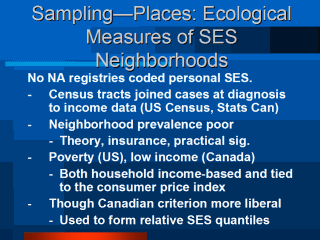| front |1 |2 |3 |4 |5 |6 |7 |8 |9 |10 |11 |12 |13 |14 |15 |16 |17 |18 |19 |20 |21 |22 |23 |24 |25 |26 |27 |28 |29 |30 |31 |32 |33 |34 |35 |36 |37 |38 |39 |40 |41 |42 |43 |44 |45 |review |
 |
In the construction of our central ecological measure of SES we focused on the prevalence of federally-defined poor people within census tracts for the following reasons. Census tracts are the most comparable units used by both the US Census Bureau and Statistics Canada. Much construct validation of such units has been accomplished, particularly by sociologists in the US (e.g., poverty areas; William Julius Wilson, The truly disadvantaged, 1987; Paul Jargowsky, Poverty and Place, 1997). Much predictive validation of such units has been accomplished, particularly in the US (e.g., Krieger N et al. The Public Health Disparities Geocoding Project. Am J Epidemiol 2002). 4) Such income-based measures are known to be intimately associated with various under- and uninsured statuses in the US, and thus, are close proxies of them. |